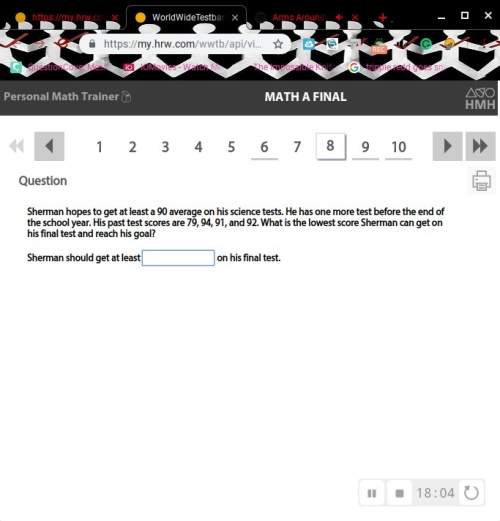
Mathematics, 18.01.2021 17:00 flowersthomas1969
Katelynn and Travis go on a trip. When they start out, their odometer reads 34,118 miles. If they drive 320 miles the first day, what will the reading on their odometer be?
Part B: Katelynn and Travis forgot to write down their mileage on the second day, but after the third day their odometer read 34,963 miles. What was the average number of miles they drove during the second and third days?
Part C: At the end of the third day, Katelynn and Travis reached their destination. They spent 4 days at their destination and then they drove home. If it only took them 2 days to drive home, what was their average number of miles driven each day, assuming they followed the same route home with no side trips?

Answers: 3


Another question on Mathematics

Mathematics, 21.06.2019 18:30
Acone with volume 1350 m³ is dilated by a scale factor of 1/3. what is the volume of the resulting cone? enter your answer in the box. m³
Answers: 1

Mathematics, 21.06.2019 20:00
The art class is planning to paint a mural on an outside wall. this figure is a scale drawing of the wall. width: 11 in length: 28 in unit rate: 1.5 ft per in. write the ratio of the area of the drawing to the area of the actual mural. write your answer as a unit rate. show that this unit rate is equal to the square of the unit rate 1.5 ft per in
Answers: 1

Mathematics, 21.06.2019 21:30
Consider a bag that contains 220 coins of which 6 are rare indian pennies. for the given pair of events a and b, complete parts (a) and (b) below. a: when one of the 220 coins is randomly selected, it is one of the 6 indian pennies. b: when another one of the 220 coins is randomly selected (with replacement), it is also one of the 6 indian pennies. a. determine whether events a and b are independent or dependent. b. find p(a and b), the probability that events a and b both occur.
Answers: 2

Mathematics, 21.06.2019 21:30
In a test for esp (extrasensory perception), the experimenter looks at cards that are hidden from the subject. each card contains either a star, a circle, a wave, a cross or a square.(five shapes) as the experimenter looks at each of 20 cards in turn, the subject names the shape on the card. when the esp study described above discovers a subject whose performance appears to be better than guessing, the study continues at greater length. the experimenter looks at many cards bearing one of five shapes (star, square, circle, wave, and cross) in an order determined by random numbers. the subject cannot see the experimenter as he looks at each card in turn, in order to avoid any possible nonverbal clues. the answers of a subject who does not have esp should be independent observations, each with probability 1/5 of success. we record 1000 attempts. which of the following assumptions must be met in order to solve this problem? it's reasonable to assume normality 0.8(1000), 0.2(1000)%30 approximately normal 0.8(1000), 0.2(1000)% 10 approximately normal srs it is reasonable to assume the total number of cards is over 10,000 it is reasonable to assume the total number of cards is over 1000
Answers: 1
You know the right answer?
Katelynn and Travis go on a trip. When they start out, their odometer reads 34,118 miles. If they dr...
Questions

Mathematics, 05.09.2020 01:01




Mathematics, 05.09.2020 01:01


Mathematics, 05.09.2020 01:01

Social Studies, 05.09.2020 01:01

Mathematics, 05.09.2020 01:01

Mathematics, 05.09.2020 01:01

Mathematics, 05.09.2020 01:01

Mathematics, 05.09.2020 01:01




Business, 05.09.2020 01:01



Geography, 05.09.2020 01:01




